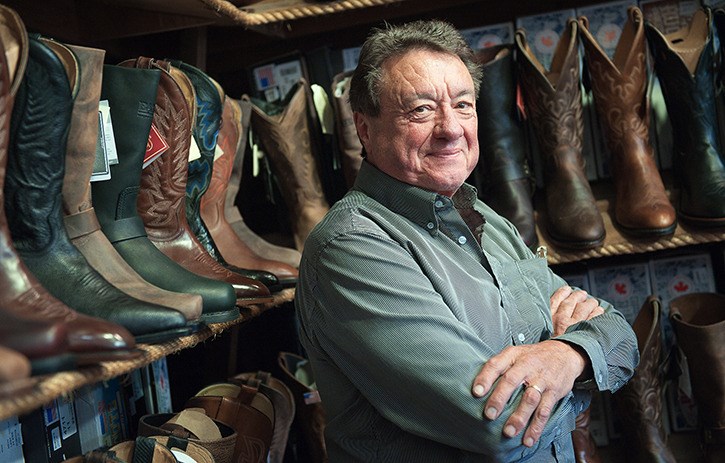They came from China in the 1880s, nestled as ballast in the holds of great ships next to fine teas and spices.
Or they came from the Bowen Island Brickyard....
Whichever local lore you choose to believe, the bricks of Gastown are the oldest in the city, and its a privileged few who get to work within their walls every day — especially given what they are witnessing lately.
O.K. Boot Corral owner Everett McGowin has been at his highly photographed Maple Tree Square location since 1991. Prior to that, his Byrnes Block space was occupied by Woodwards department store, and he was clocking in just across the street.
A shoe man since his days at Agnew Surpass Footwear in 1959, McGowin says he chose Gastown for his burgeoning boot business in the '80s in the hopes that the neighbourhood would return its '60s glory days of great stores and restaurants — a place tourists and locals came to hang out.
And if you follow the arrhythmic history of Gastown, you'd notice it was only a matter of time before his prediction came true:
The city's first downtown core, Gastown was historically the site of industry, rabble and rouse. Built around Gassy Jack Deightons saloon in 1867, it was a trade centre and playground for transient loggers and seafarers. When all but two of its 400 buildings were destroyed in 1886 by the Great Fire, the area quickly bounced back, rebuilding and continuing to thrive.
Then, in the lead up to the 1930s, it found new purpose as the centre of the citys wholesale produce distribution, while remaining the centre of the citys libational life (picture 300 licensed establishments within a 12-block area).
But onward came the Great Depression and, when it hit, Gastown spiraled into an overlooked confluence of cheap beer parlours, flophouse hotels, and logger halls.
By the 1960s, Gastown had reached a nadir of disrepair. Its pulse was thready, but a revival was brewing anew:
The area slowly evolved into a popular shopping district by day, and a place to drink and dance late into the night.
And when its distinctive and historic architecture, like that of nearby Chinatown and Strathcona, was put at risk scheduled to be demolished to build a major freeway into downtown, a passionate campaign — led by concerned businessmen, property owners and political protestors — caught figurative fire, and the provincial government declared the area a protected heritage site in 1971.
By the early '80s and into the '90s however, as crack cocaine flooded the market, businesses again began leaving en masse and the drug and sex trade strangled the area for at least two decades.
At the start of the 2000s, a new movement took hold; an advancing guard of restaurateurs staked their claims to the cobblestone streets of the besieged Downtown Eastside stronghold, lured back by cheap rents, inspiring canvases and new development. First were Salt and Chill Winston, in 2006, and then Boneta in 2007.
By 2010 it was being loudly touted by local media as a culinary it district. In 2012 it was named fourth most stylish neighbourhood in the world by Complex magazine.
"It is all very exciting," McGowin shares. "Gastown certainly has evolved back to like it was in the late 60s. It is also a welcome sight to see that the area is inhabited primarily with independents."
For some, though, Gastowns grittiness is no style statement, and anti-gentrification protests began in earnest in 2013, marking Gastown as a hotly contested territory.
Through all of this, McGowin has seen his own ups and downs.
His business grew steadily after opening: line dancing surged in popularity and the Western scene was en vogue. Everyone was wearing western boots in the late '80s and early '90s, he recalls with a smile.
During the early morning of Oct. 7, 2007, however, his store sustained a near-fatal blow.
A speeding car, being chased by local authorities, ended up losing control and hurtling inside the store. The shop sustained in excess of $20,000 in damage, and, consequently,was closed for months.
A year later, another car, again speeding through the reedy morning light, sheered off a lamp standard and the pole catapulted into the store, causing approximately $50,000 in damage and rendering the store inoperable for two more months.
But McGowin says he is still sold on two things: his vocation and his location, and, as result, is at ground zero of Gastown's fifth epoch the Feastocene unfolding around him.
More than three dozen new restaurants have opened in Gastown. Restaurateur Mark Brand went into retail with Sharks and Hammers, and the Secret Location retailers opened a concept restaurant. The iron couldnt be hotter.
Even McGowin's Byrnes Block is now fortified for the next century by restaurants Peckinpah, Six Acres, Veras Burger Place, LAbattoir, Cork and Fin.
"I welcome the restaurants. I'm open now until eight to capture some of the passers by and it has been working. Its my understanding that others are considering this avenue, as well."
My only concern is that, with the influx of the restaurants and bars, rents will probably increase substantially. But I am going to hang in where I am as long as possible, vows the 72-year-old.
So for some, there is the danger of having too much a good thing, but it would seem Gastown is betting on the old saying that the best way to a citys heart is through its stomach. At least this time around.
Maple Tree Square at the corner of Abbott and Water Streets (shown here just prior to the Great Fire of 1886) was a common meeting place. The man with his back to the camera in the centre of the photo is J.M. Spinks. The bearded man he is talking to is George Byrnes. [Photo VPL 1093]



